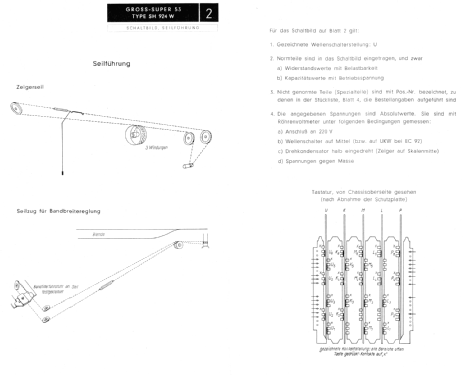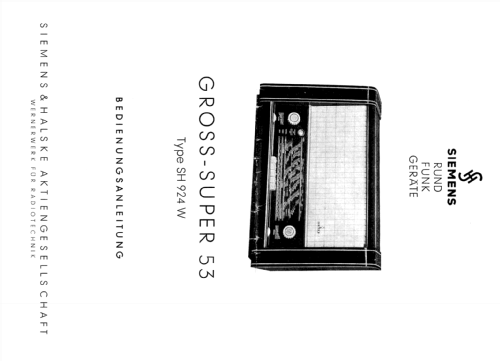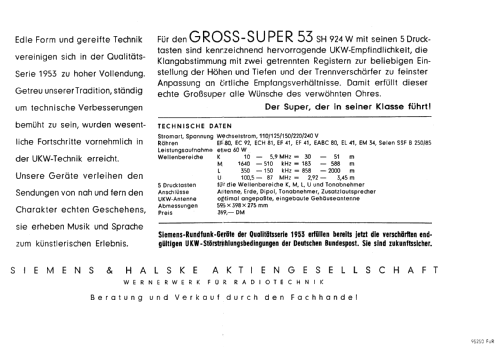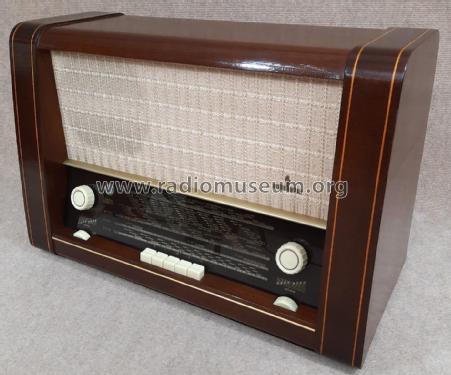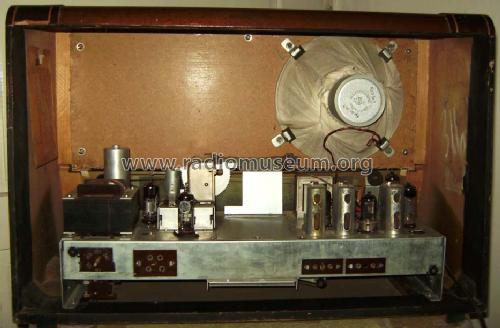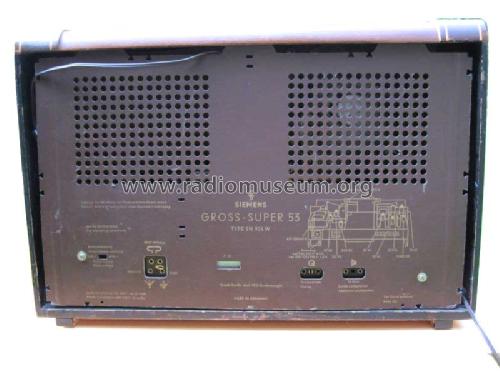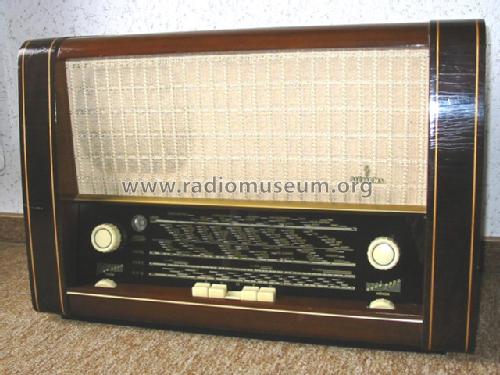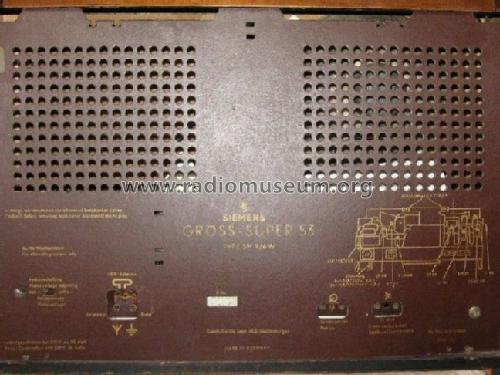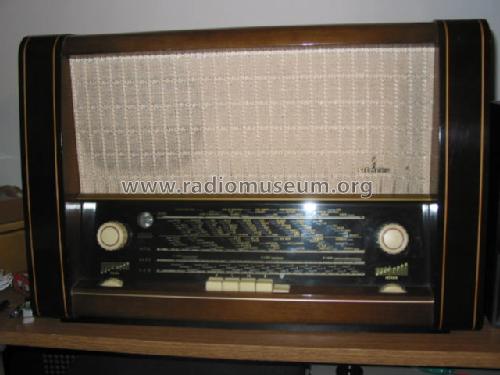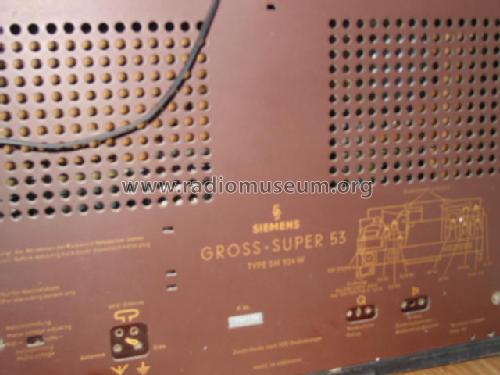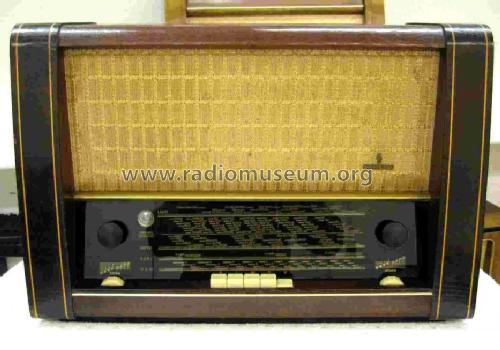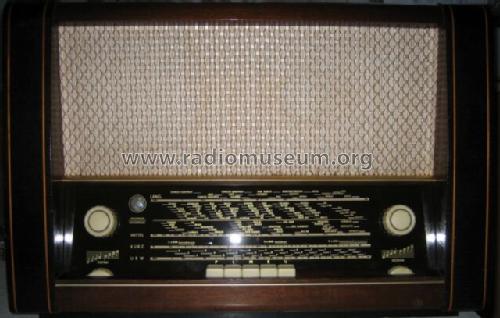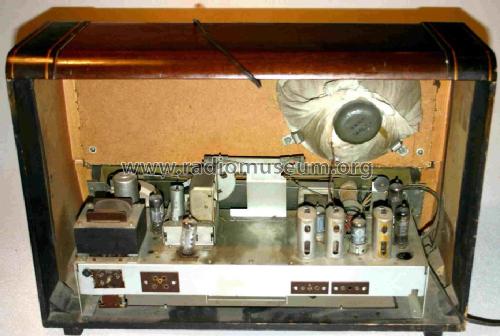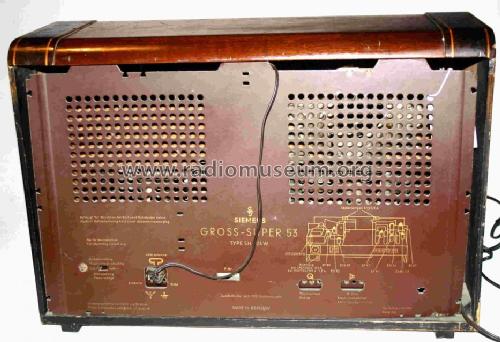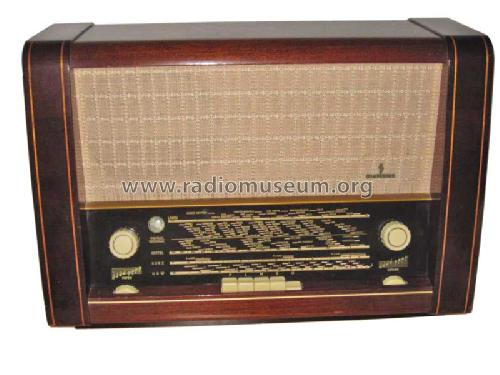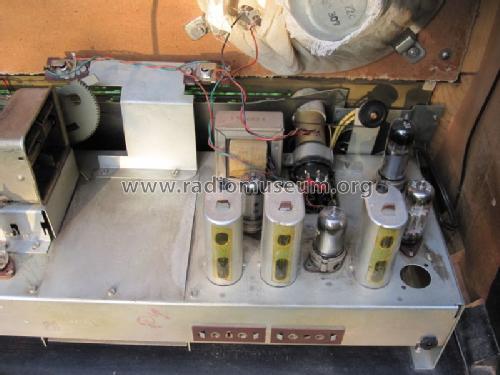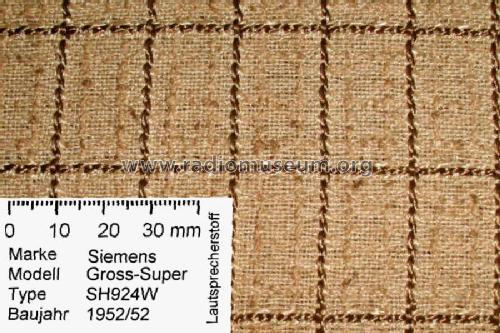Gross-Super 53 SH924W
Siemens (& Halske, -Schuckert Werke SSW, Electrogeräte); Berlin, München
- Pays
- Allemagne
- Fabricant / Marque
- Siemens (& Halske, -Schuckert Werke SSW, Electrogeräte); Berlin, München
- Année
- 1952/1953
- Catégorie
- Radio - ou tuner d'après la guerre 1939-45
- Radiomuseum.org ID
- 5203
Cliquez sur la vignette du schéma pour le demander en tant que document gratuit.
- No. de tubes
- 8
- No. de transistors
- Semi-conducteurs
- SSF250/85B
- Principe général
- Super hétérodyne (en général); FI/IF 468/10700 kHz
- Circuits accordés
- 8 Circuits MA (AM) 11 Circuits MF (FM)
- Gammes d'ondes
- PO, GO, OC et FM
- Tension / type courant
- Alimentation Courant Alternatif (CA) / 110, 125, 150, 220, 240 Volt
- Haut-parleur
- HP dynamique à aimant permanent + bobine mobile / Ø 20 cm = 7.9 inch
- Matière
- Boitier en bois
- De Radiomuseum.org
- Modèle: Gross-Super 53 SH924W - Siemens & Halske, -Schuckert
- Forme
- Modèle de table avec boutons poussoirs.
- Dimensions (LHP)
- 595 x 398 x 275 mm / 23.4 x 15.7 x 10.8 inch
- Remarques
-
Regelbare Bandbreite. Lautsprecher mit Alu-Gusskorb, Impedanz: 16 Ohm
Siehe auch gleiches Modell in der Schweiz.Der Katalog des Rundfunk-Grosshandels führt das Gerät irrtümlich mit einer Höhe von 298 mm und einem Gewicht von 15 kg.
- Poids net
- 13.3 kg / 29 lb 4.7 oz (29.295 lb)
- Prix de mise sur le marché
- 399.00 DM
- Source
- Kat.d.Rundf.GrossH.1952/53 / Radiokatalog Band 1, Ernst Erb
- Schémathèque (1)
- -- Original-techn. papers.
- D'autres Modèles
-
Vous pourrez trouver sous ce lien 2543 modèles d'appareils, 2154 avec des images et 1347 avec des schémas.
Tous les appareils de Siemens (& Halske, -Schuckert Werke SSW, Electrogeräte); Berlin, München
Collections
Le modèle Gross-Super 53 fait partie des collections des membres suivants.
- Peter Breu (D)
- Hans-Werner Ellerbrock (D)
- Nico Jacobsen (D)
- Otto Kippes † 24.4.17 (D)
- Gaby + KH Mallinger † 18.8.23 (A)
- Klaus Michels † (D)
- Bernhard Nagel (D)
- Manfred Rathgeb (D)
- Roland Rauch (D)
- Klemens Rhode (D)
- Werner Riethmüller (D)
- João-Afonso Santos (P)
- Rico Schmuchert (D)
- Wolfgang Winkler (D)
Contributions du forum pour ce modèle: Siemens & Halske, -: Gross-Super 53 SH924W
Discussions: 2 | Publications: 5
Guten Tag an die Gemeinschaft
ich habe vor einiger Zeit eine Drehkondensator-Einbautuner mit 7-poligem Röhrensockel bekommen, angeblich ein SIEMENS UKW-Einbautuner.
Ich bin aber hier mit der Gerätesuche nicht fündig gewordem
Kann mir jemand sagen, aus welchem Gerät der stammt und welche Röhre da reinkommt ... Schaltplan wäre natürlich ganz super.
lg
Gerhard
Gerhard Schoenbauer, 13.Apr.20
Intermittent Audio Level from Embrittled Rivets in Volume Control
I obtained a beautiful Gross Super 53 in 2005 (SH 924 W), with a nearly perfect cabinet and very clean chassis for $175 on e-bay. During its restoration I came across an interesting problem that may be of help to restorers of radios of this era, and a gentle warning too. After extensive replacement of virtually all of the capacitors, and substitution of 1N4005’s for the high resistance rectifiers, I was initially rewarded with a wonderful sounding radio. Prior to starting alignment, I let it play but noted that from time to time the audio level would fall dramatically, and by pushing any of the piano keys, the audio would return to normal levels. Unfamiliar with these keys, I first assumed that the problem was in a dirty connection in the switch levers associated with the keys. A dramatic cleaning followed with an American product called “Big Bath”. It should have been called “Big Mistake.” It certainly cleaned, then promptly softened the cores of most of the tunable coils, and I watched with horror as the slugs sagged, then hardened into new positions from which they could not be subsequently budged. (Until one-for-one replacement 4 years later from a ’53 that had been wrecked in shipment to me, the calibration remained a bit goofy on every band.)
But still, no cure for the volume problem until I accidently tapped the volume control directly after loss of volume. That is where the problem was really centered. The shock of activating the piano keys simply jolted the control itself, and in fact, the piano keys were never really an issue.
But what was the actual problem? Aggressive cleaning of the control was useless, and I finally disassembled it completely. The real problem was the brass rivets that connected the carbon raceway to the contacts on the opposite side of the phenolic, and careful measurements with an ohmmeter confirmed the intermittent connection. (The first picture attached below shows the rivets from the carbon raceway side.) My first attempt to repair simply soldered the rivets on the opposite side to the connections (shown in the second figure). This failed too, as the real problem was that the brass rivets had become embrittled and were incapable of providing the necessary tension against the raceway. Low power microscopic examination of the rivets strongly suggested that they had become quite granular in appearance, supporting this potential interpretation.
In the end, I carefully drilled out the rivets, and used them as washers beneath 2-56 screws and nuts, installed, gently tightened and trimmed with a Dremel tool (screw heads facing the raceway side). In my excitement of its success, I failed to leave a photo record, so you will have to imagine this step! The control was carefully reassembled (some dots of epoxy helped), and the radio has worked faithfully for some 6 years now. With all the grief to make it work and my foolishness with “Big Bath”, it remains my favorite.
Frank Pascale, 23.Apr.11



